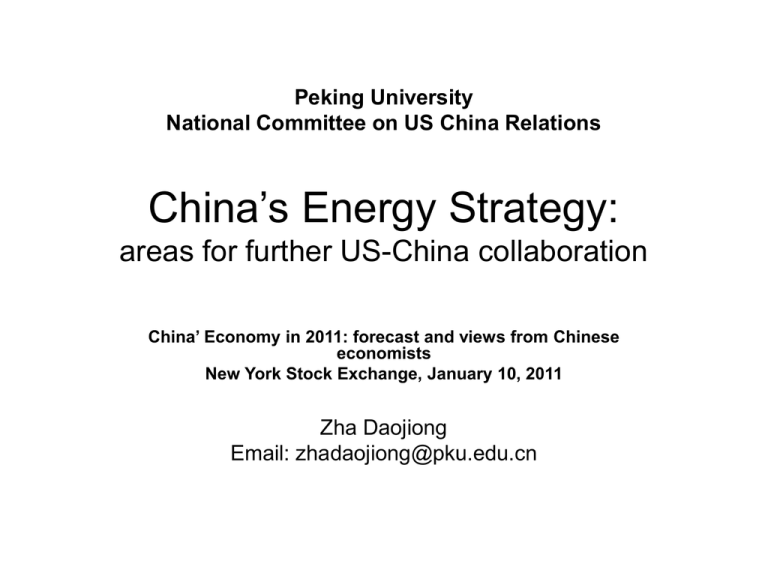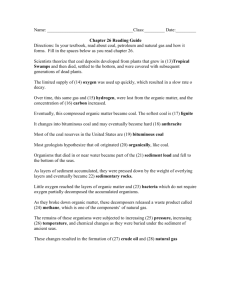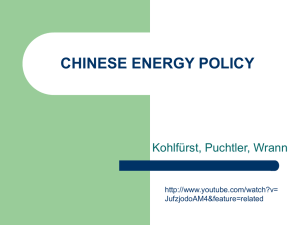幻灯片 1 - National Committee on United States
advertisement

Peking University National Committee on US China Relations China’s Energy Strategy: areas for further US-China collaboration China’ Economy in 2011: forecast and views from Chinese economists New York Stock Exchange, January 10, 2011 Zha Daojiong Email: zhadaojiong@pku.edu.cn Broad picture • Overall philosophy behind energy policy: maximize domestic capacity to meet supply needs – Current level of self-sufficiency: 90% – Level of dependence on imports • Oil: 55% in 2010; natural gas: 5%; coal: <1% • All set to grow • Macro-level energy policy instruments – Energy intensity target, as of 11th FYP • Drop by 20%, 2010 (base year 2005) – Total consumption control target, beginning with 12th FYP • 4.5-4.9 btce [per capita 3.1-3.4 tce; cf: 2.38 tce in 2010] • 15% from non-fossil fuel sources, by 2020 • CO2 intensity to drop by 40-45% in 2020 (base year 2005) Projected non-fossil fuel composition, 2020 Hydro 41-48% Nuclear 21-25% Wind 8-13% S olar 1% Biomass 2-3% Other renewables 17-19% Source: State Grid Company study 3 Old challenges remain • Coal being the #1 source of primary energy – 3.2 btce consumed in 2010 • 68% of total energy – When annual increase stays at 170 mtce 4 btce by 2015 • Net importer of coal – Since 2008; 160 million tons in 2010 • Power consumption in coal-rich provinces set to see double-digit growth – Anhui, Chongqing, Guizhou, Hebei, Inner Mongolia, Shangdong, Shanxi – Major cause: transfer of industrialization from coastal areas – Unavoidable phase in poverty alleviation and urbanization Coal: international collaboration • More efficient electricity transmission – Smart grid, smart meters • More efficient thermal power generating units – Average per kwh coal use: 340 grams • 270 grams for top notch domestic facilities Source: W. Chen, "Clean Coal Technology Development in 5 Coal: international collaboration • Progressive pricing for electricity – Nation-wide plan announced in December 2010 – NEEDED: Business models for incentivizing household conservation • Metering residential heating, announced in 2010 – North of Yellow River, average community heating for 125 days – NEEDED: Retro-fitting buildings, commercial and residential – NEEDED: Making the meters,… • Coal liquefaction, gasification – Water, environmental and social constraints – NEEDED: Selected treatment of enthusiasm from within China Natural Gas • Consumption constrained by supply – Average 9.9 b cf per day, first half of 2010 • increase by 18.3%, y-o-y • Massive investments to bring in external supply by land – Pipelines from Central and South Asia – Import accounts for 12% of total gas consumption, 2010 • Desirable future: expanded import of LNG – Cleaner fuel for consumption in coastal areas – Direct energy savings on energy transport from far-flung regions of China, north, northwest, and southwest – Demonstration effect on managing geopolitical concerns • More collaboration over unconventional gas – Coal-bed methane, 2.6 bcm in 2010 in China, cf: 80 bcm in US – Shale gas extraction Last but not least • Foster policy discussions to promote deeper mutual energy market integration – More energy-related manufacturing by Chinese companies in the United States • Suntech’s plant in Arizona, 2010 – Chinese and American oil companies jointly bid for projects in third-country upstream markets • BP and CNPC in Iraq, 2009 – Integrated energy business for American companies to service China • Joint refinery project among, ExxonMobil, Saudi Aramco, Fujian government, 2007 Thank you for listening • Questions and comments welcome











